ViewZone asked me to write a story about the Mayan Calendar. There is acommon belief that the calendar holds a prophecy that the world willend in 2012. I knew very little about the whole topic when I begandoing the research. I like to think I had an open mind. Myinvestigation began with mainstream archaeology and expertinterpretations of the calendar. But it soon took a turn that made myhair literally stand on end. I am now convinced that these propheciesare true.
To understand what is likely to happen to Earth and its people, youwill need to remain calm and try to follow the facts. It's not assimple as some people describe. It requires an understanding of somefairly complicated science, but I think I can explain this in a waythat you will easily understand.
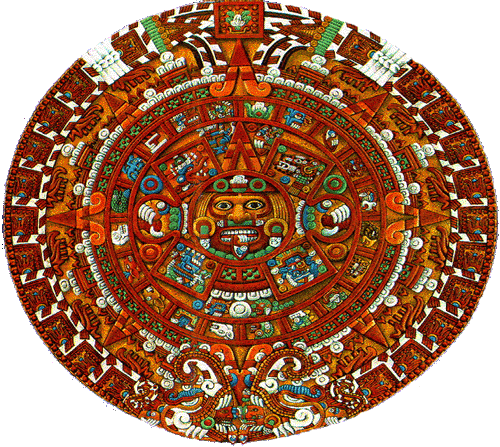
The Calendar -- A Descrption
First, the Mayan calendar is also sometimes called the Aztec Calendar.This calendar is recorded as a carving on the Aztec "sun stone,"currently on exhibit in the National Museum of Anthropology and Historylocated within Chapultepec Park, Mexico City. There's a lot we couldsay about this carved stone but most of those details are irrelevant tothe "end times."
Our modern calendar, called the Gregorian Calendar, has days, weeks, months and years. In the Mayan Calendar it's more complex. In fact, it's really three calendars at the same time.
First there's a religious calendarthat takes 260 days to complete a full religious cycle. There are 20"weeks" made up of 13 days. Each week has a special name, a graphiclogo and unique meaning associated with it. This reminds me of theChinese years which cycle through "the year of the rat" and "the yearof the monkey," etc., each with it's special image and meaning.

Graphic logos for each of the 20 religious weeks.
Next there is the solar calendar.This has 365 days, like our modern calendar. It's divided in 18 monthsof 20 days each. At the end of the cycle there's five special daysconsidered to be unlucky because they don't belong to any month. Eachof the months has a special name, graphic logo and some specialsignificance, similar to the icons for the weeks in the religiouscalendar.
So it is possible, for any specific date, the calculate the religiousweek and the solar month and to predict the influences that might beguiding fate. But that's not really what's involved with the prophecyof 2012. To understand that we must look at the third calendar, calledthe long count.
While the first two cycles could be thought of as cogs or gears (seebelow) revolving through time, the long count is a linear number ofdays, starting from the first day, "1," and counting through each dayto the present. Any day in history can be recorded using the long countand, with some simple mathematics, the corresponding religious week andsolar month can also be found.
In writing this article, I thought about creating a javascript programthat would do this calculation. My friend, Gene Matlock, then told methat when he was in Mexico, he found a place that sold wooden,mechanical calculators with gears that did just that. He said thatMexicans sometimes used these mechanical calendars to foretell thefuture or to find auspicious times for special events like marriage orbirths. Anyway, although it might be nice to know the religious andsolar significance, it's the long count that foretells Doomsday.
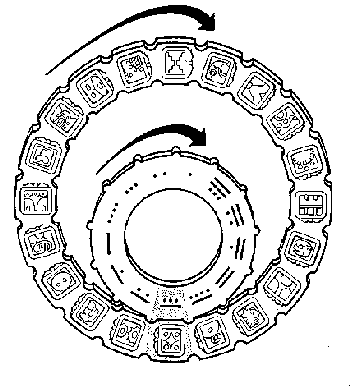
Cog or "gears" can be used to compute the religious and solar cycles for any date.
The days of the long count are numbered with an unusual system. Insteadof writing numbers as we do, from right to left with each place being amultiple of 10 (i.e. 10000, 1000, 100, 10, 1), the Mayans had only 5places.
The first place recorded a number from 0 to 20. To the left, the secondplace could have a range from 0 to 17; the third from 0 to 19; thefourth from 0 to 19 and the last from 0 to 12. The numbers were writtenfrom right to left, like our system, separated by a dot. Instead ofmultiples of 10, the first place had a multiple of 1 (like our system);the second place a multiple of 20; the third a multiple of 360; thefourth a multiple of 7200 and the fifth a multiple of 144000.
So a long count number, for example, could be written as 4.12.5.9.0 and would be calculated as follows:
(4 x 144000) + (12 x 7200) + (5 x 360) + (9 x 20) + (0 x 1) or a long count of 145980.
It's not too difficult to realize that the maximum number which can be recorded this way would be 12.19.19.17.20, although some researchers like to write it as 13.0.0.0.0. This amounts to a long count number of 1,872,000 days or 5125.36 years of our modern calculations. Obviously, the calendar is very old!
Over the years, archaeologists have found carved monuments thatrecorded the long count for known dates in Mayan history. Once a datewas fixed in time, it was easy to determine "day 1" as August 11th, 3114 BC. And it was also easy to calculate the date at which the calendar would end -- December 21st, 2012.
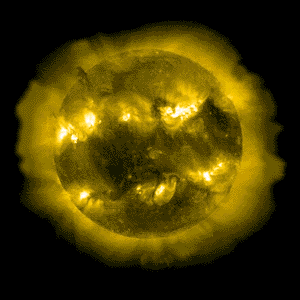 Trustme, just because the calendar ends doesn't prove that time, or theworld, or life will end. We need to look carefully at December 21, 2012and try to understand why the Mayans never calculated a date beyondthis point in time. To do this we must move from Archaeology to thescience of Astronomy and Astrophysics.
Trustme, just because the calendar ends doesn't prove that time, or theworld, or life will end. We need to look carefully at December 21, 2012and try to understand why the Mayans never calculated a date beyondthis point in time. To do this we must move from Archaeology to thescience of Astronomy and Astrophysics.
It's all about the Sun
It's ironic (or maybe not) that the Mayan Calendar is often called the"sun stone." While the calendar does have "solar" days, acknowledgingthe 365 days it takes for Earth to rotate around the Sun, it is alsotrue that the Sun plays a key role in the final day of the "longcount." To understand what will happen to the Sun on December 21, 2012,we need to review some scientific terms like "ecliptic," "barycenter,"and "sunspots." These are important in the discussion that follows.We'll start with the most difficult one first.
| Terms we will encounter... What is the Barycenter? You've no doubt heard that Earth revolves around the sun. Well, actually, that's not quite true! Haveyou heard the term "center of gravity"? It's a technical-sounding termfor something pretty simple. It's the exact center of all the material(that is, mass) that makes up the object. For example, if you have astraight stick, like a ruler or yardstick, there's a place at themiddle where you can balance it on your finger. That's its center ofgravity.  Butthe center of gravity may or may not be the point that is exactly inthe middle, distance-wise, of the object. Some parts of the object maybe heavier (denser) than others. If you have something like a sledgehammer that is heavier on one end than the other, the center of gravitywill be much closer to the heavy end than the lighter end.  Toget an idea of where the center of gravity is, rest the ends of anyobject like the ruler or a pencil on one finger from each hand. Slowlymove your fingers together without dropping the object. Your fingerswill meet underneath the object's center of gravity. You can balancethe object on one finger at that special place. The actual center of gravity could be close to thesurface or deep inside, depending on whether the object is flat like aruler or a dinner plate, or "three-dimensional," like a box or a ball.And if you let the object spin (like when you throw it), it will try tospin about that point. In the case of the Earth and the sun, both bodiesactually revolve, or spin, around the very center of the mass (similarto center of gravity) between them. This point is called the"barycenter." Earth and the sun are "connected" by the gravity pullingthem together. It's just like the light end and heavy end of the sledgehammer. Compared to the size of the sun, Earth is about like a flea ona cat! So the center of mass between the Earth and the sun isalmost--but not quite--the very center of the sun. In the case of a planet the size of Jupiter, which is318 times as massive as Earth, the barycenter of Jupiter and the sun isa bit further from the sun's center. So, as Jupiter revolves around thesun, the sun itself is actually revolving around this slightlyoff-center point, located just outside its center. Thus, a planet thesize of Jupiter will make the sun (or any star) appear to wobble a tinybit. This picture shows you that the center of mass and barycenter canbe slightly different points. It isn't meant to be very accurate! 
Wecan take advantage of this bit of knowledge and look for large planetsin other solar systems by learning to detect this type of tiny wobblein the star's position. |
For now, let's forget all the small planets and focus on Jupiter. Itmakes one complete trip around the Sun every 11.861773 years. There's anew theory put forth by Dr. Rollin Gillespie which shows that Jupiter,and to a smaller degree the other less massive planets, may trigger the11 year cycle of sunspots and solar flares.
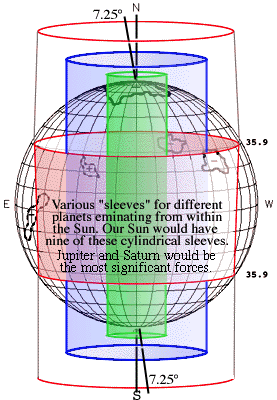 Here's how it works.
Here's how it works.
The barycenteris not a single point in the Sun. Because the Sun is a rotating gaseoussphere, the barycenter forms a vertical, cylindrical "sleeve" that ispartially inside and outside the main solar body. All of the planetshave such a "sleeve," one inside the other, depending on their relativemass and the location of their barycenters. The particular sleeverepresenting the mass of Jupiter intersects the solar surface at 35.9degrees North and South. This is precisely where sunspot and flareactivity begin and end during each 11 year cycle.
The new cycle has already begun with the recent observation of a solarspot with reverse polarity. But some surprising activity on March 27,2008, shows some huge eruptions with M-class radiation at about theequatorial region of the Sun. [ See Solar Map].These surprising eruptions suggests a barycenter of disturbance from anobject even more massive than Jupiter, placing the "sleeve" outside theSun. Could this be the beginning of the Galaxy's effects (keep readingto learn more about this) on our Sun?
Scientists have noted that when Jupiter and Saturn are aligned on thesame side of the Sun, the solar activity is at its minimum; when theyare on opposite sides of the Sun the solar activity is at its maximum.The positions on December 21, 2012 are ideal for extreme solar activity.
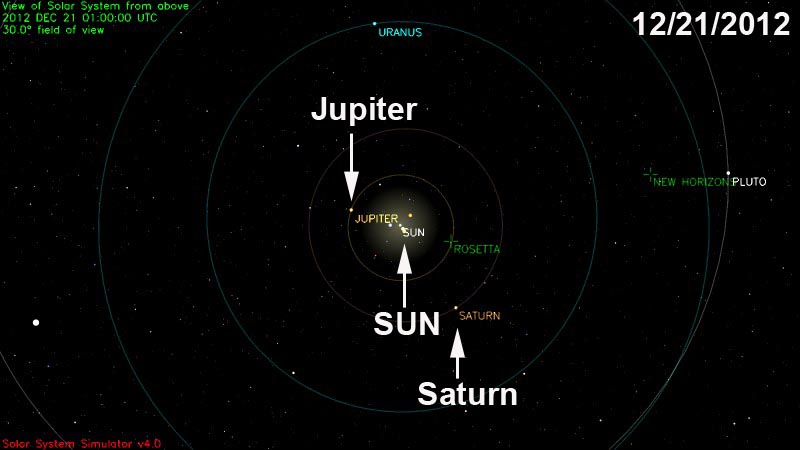
Above: Position of Jupiter and Saturn on 12/21/2012.
These cylinders are usually quite orderly because the planets adhere to a narrow plane, called the eclipticwhich resembles a thin plate extending from the equator of the Sun. Theplanets hang out here because (in simple terms) this is the zone wherethe gravitation of the system is the strongest. (see below)
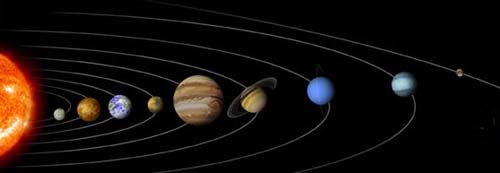
The planets orbit the Sun in a narrow plane called the ecliptic.
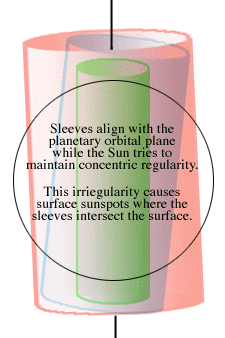
Butnature is never perfect. The Sun rotates at a slight angle (7.25degrees), much as our Earth does. As it wobbles, it tilts the sleeves,causing them to clash with eachother and eventually disrupt thesurface. Havine the barycenters of the to most massive planets, Jupiterand Saturn, in maximum misalignment is especially disruptive. Thisdisturbance, to put it simply, works its way to the surface and eruptsin sun spots and solar flares or CME's (Coronal Mass Ejections).
The last solar cycle was at its maximum in 2001. Each active solarcycle has a period when the flares are strongest, usually happeningnear the solar equator, called the "solar maximum." This is significantbecause the next "solar maximum" event will coincide with December 21, 2012. But wait -- there's much more!
Solar flares are pieces of the sun which leap into space, dischargingradiation and strong electrical currents that travel outward intospace. They often fall back to the surface of the Sun. Sometimes, avery strong flare, called a Coronal Mass Ejection (CME), actuallyleaves the Sun and this deadly mass shoots out from the Sun towards theplanets like a bullet. Usually these CME's don't hit anything butoccasionally they hit a planet like Earth. Some believe a powerful CMEonce hit Mars.
Most solar flares are small. But even a small flare can be dangerous.In 1989 a flare hit the North American continent and fried electriclines, zapped power grids in the US and Canada, and created large powerbackouts. Flares can also effect our moods and physical health. Intheory, a large flare impacting the Earth could zap the ionosphere(there goes all the satellites, cellphones, GPS...) and irradiate thesurface, killing every living organism that it touched.
Solar flares and sun spots have an average cycle of 11.120412 years(estimated from one "solar maximum" to the next). Right now, 2007, weare in a relatively quiet part of the cycle. The small discrepancybetween this figure and the 11.861773 year period of Jupiter is closeenough to be significant but suggests that something else is alsoinfluencing solar disturbances. Sure, it could be attributed to thevarious positions of the other less massive planets, but it could alsobe something even more significant -- the Milky Way.

The Galactic Alignment of December 21, 2012
The Perfect Storm
Our solar system is part of a huge disc shaped collection of stars andplanets called the Milky Way. We're located somewhere on the edge ofthe disc, slightly on top of the narrow disc. But very soon we'll bemoving to the bottom of the disc. This change, from top to bottom,begins on December 21, 2012.
Yes, that's right. On the same day when our Sun is at it's solarmaximum, something will happen that's never happened before -- theecliptic of our solar system will intersect with the Galactic plane,called the "Galactic Equator" of the Milky Way! [see star chart].
If you imagine our solar system as a bunch of peas on a plate, with ahuge meatball in the center, imagine the Milky Way as a city-size pizzawith the "Guiness World Book Record Meatball" in its center!
Prior to December 2012 we have been drifting on the top of the pizza,never really able to see the bottom. The plate and pizza are notparallel. They are moving at different angles. We've been driftingdown, down, down... and on December 21st, 2012, we will be exactlylevel with the crust -- forming an "x" at the Galactic Equator wheregalactic gravity is the strongest. After 2012, if we are still here, wewill be passing through the bottom zone, viewing the Milky Way pizzafrom the South.
Yes, there's even more!
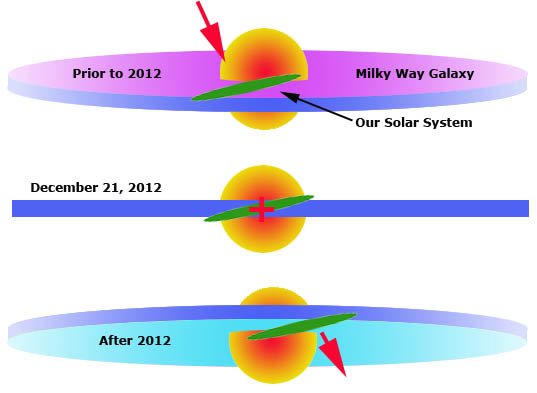
By some amazing coincidence, not only will we be intersecting with theGalactic Equator, but we will be doing this precisely aligned with thecenter of the Galaxy where there is maximum mass! More mass means moregravity. More gravity means more influence from those barycenters inour Sun. That means exponential increases in solar disruptions -- allcoinciding on the same day! Whew!
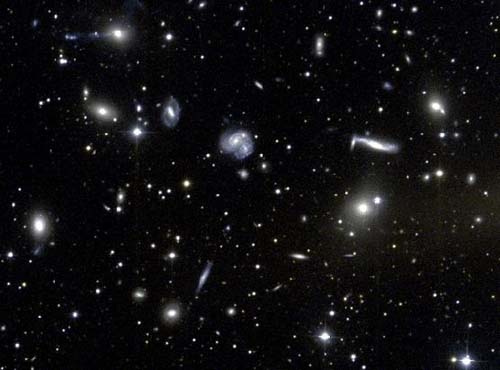
[Above:The Hercules Cluster of galaxies. This group of galaxies is heldtogether by the gravitational attraction or "pull" of each individualgalaxy on the others in the group. This demonstrates the enormousgravity contained in a galaxy, such as our own Milky Way.]
An apology and acknowledgement
OK. This has been a "light weight" description of what's going tohappen. It has been simplified to the point where some scholars andscientists could argue about my presentation. But the main facts aretrue. The date, December 21, 2012, is a special day. It represents themaximum possible influences for solar flares that the universe canprovide. Undoubtedly the Mayans, or the civilization that influencedthem, somehow knew about these things.
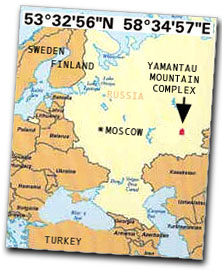 Overthe last decade, I have written a variety of stories about such thingsas underground cities and government actions that could only make senseif there were no future. I cannot help but think that maybe they, likethe Mayans, know about these things. I'd specifically like to suggestthat readers take another look at the underground complex at Yamantau that the Russians are building. Could this be a haven for surviving a solar blast? And the "doomsday seed bank"that's being filled deep inside an Arctic island. And what about pastevents? Did the Hopi go underground to survive a similar eventthousands of years earlier? Should we be going underground also?
Overthe last decade, I have written a variety of stories about such thingsas underground cities and government actions that could only make senseif there were no future. I cannot help but think that maybe they, likethe Mayans, know about these things. I'd specifically like to suggestthat readers take another look at the underground complex at Yamantau that the Russians are building. Could this be a haven for surviving a solar blast? And the "doomsday seed bank"that's being filled deep inside an Arctic island. And what about pastevents? Did the Hopi go underground to survive a similar eventthousands of years earlier? Should we be going underground also?
It's also important to stress that December 21, 2012 is only the "solarmaximum" but that the gravitational effects of the Galaxy have alreadystarted to assert their influence on the Sun. The drift towardsalignment with the galactic equator is relatively slow and, in truth,has already started. But the precise culmination of this, plus thealignment of Jupiter and Saturn all make 12/21/12 an onimous date.
I especially want to thank Dr. Rollin Gillespie, a man with whom Icorresponded for ten years and who first developed the idea thatplanetary multi-body systems could be at play in the causation of solarflares. More of his work can be read on a special page on Viewzone.
Please let's have your input on this important issue. It's only sixyears away. Who knows, perhaps the influences of these disruptions willbegin well before the solar and Galactic maximum is reached. We may nothave that much time left. Here are some additional links to storiesthat may help understand the possibilities facing our planet and us.
Part 2 - The Previous Doomsday of 12,950 BC: what was it like?Here are some other articles on this subject that you will find very interesting:
We're Not From Milky Way Galaxy - evidence our system is part of a dwarf galaxy that is being "eaten" by the Milky Way.
Will the Mayan Prophecy Really Happen? - an interesting view from Gene Matlock.
Sidereal Time and ESP -- exploring the psychic connection of our Galaxy's center.
Back to ViewZone || Submit Comments | Read CommentsComments:
Physicists Find Evidence For Highest Energy Photons Ever Detected From Milky Way's Equator
(ScienceDaily) - Physicists at nearly a dozen research institutions,including New York University, have discovered evidence for very highenergy gamma rays emitting from the Milky Way, marking the highestenergies ever detected from the galactic equator. Their findings,published in the Dec. 16 issue of the Physical Review of Letters, wereobtained using the Milagro Gamma Ray Observatory, a new detectorlocated near Los Alamos, N.M., that allows monitoring of the northernsky on a 24-hour, 7-day-per-week basis.
Gamma rays are considered by scientists to be the best probe of cosmic rays outside the solar neighborhood.
Theresearch team, which includes nearly 40 physicists, reported thatMilagro, positioned at an altitude of 8600 feet in the Jemez Mountains,detected a signal along the galactic equator region and interpreted itas arising from gamma rays with a median energy of 3.5 trillionelectron-volts, or 3500 times the mass-energy of a proton. Previoussatellite experiments have seen gamma-ray emissions along the galacticequator reaching up to energies of only 30 billion electron-volts.
These emissions are understood to be produced by interactions ofcosmic-ray particles with the abundant interstellar medium near thegalactic equator. Previously, some researchers had speculated thatadditional mechanisms were needed to explain the large number ofparticles observed at high energies. However, the measurements byMilagro can be understood by assuming a cosmic ray energy spectrum nearthe galactic center similar to that in the solar system and thestandard properties of particle interactions.
The results presented in the Physical Review of Letters paper weregathered over a three-year period, beginning in July 2000. --end
IMPORTANT UPDATE: January 2009:
Scientists have found two large leaks in Earth's magnetosphere, theregion around our planet that shields us from severe solar storms.
The leaks are defying many of scientists' previous ideas on how theinteraction between Earth's magnetosphere and solar wind occurs: Theleaks are in an unexpected location, let in solar particles in fasterthan expected and the whole interaction works in a manner that iscompletely the opposite of what scientists had thought.
The findings have implications for how solar storms affect the ourplanet. Serious storms, which involved charged particles spewing fromthe sun, can disable satellites and even disrupt power grids on Earth.
The bottom line: When the next peak of solar activity comes, inabout 4 years, electrical systems on Earth and satellites in space maybe more vulnerable.
How it works
Earth's magnetic field carves out a cavity in the sun's onrushingfield. The Earth's magnetosphere is thus "buffeted like a wind sock ingale force winds, fluttering back and forth in the" solar wind, Sibeckexplained.
Both the sun's magnetic field and the Earth's magnetic field can beoriented northward or southward (Earth's magnetic field is oftendescribed as a giant bar magnet in space).
The sun's magnetic field shifts its orientation frequently, sometimesbecoming aligned with the Earth, sometime becoming anti-aligned.
Scientists had thought that more solar particles entered Earth'smagnetosphere when the sun's field was oriented southward (anti-alignedto the Earth's), but the opposite turned out to be the case, the newresearch shows.
The work was sponsored by NASA and the National Science Foundation andbased on observations by NASA's THEMIS (Time History of Events andMacroscale Interactions during Substorms) satellite.
How many and where
Essentially, the Earth's magnetic shield is at its strongest when scientists had thought it would be at its weakest.
When the fields aren't aligned, "the shield is up and very fewparticles come in," said physicist Jimmy Raeder of the University ofNew Hampshire in Durham.
Conversely, when the fields are aligned, it creates "a huge breach, andthere's lots and lots of particles coming in," Raeder added, at thenews conference.
As it orbited Earth, THEMIS's five spacecraft were able to estimate thethickness of the band of solar particles coming when the fields werealigned — it turned out to be about 20 times the number that got inwhen the fields were anti-aligned.
THEMIS was able to make these measurements as it moved through theband, with two spacecraft on different borders of the band; the bandturned out to be one Earth radius thick, or about 4,000 miles (6,437kilometers).
Measurements of the thickness taken later showed that the band was also rapidly growing.
"So this really changes our understanding of solar wind-magnetospherecoupling," said physicist Marit Oieroset of the University ofCalifornia, Berkeley, also at the press conference.
And while the interaction of anti-aligned particles occurs at Earth'sequator, those of aligned particles occur at higher latitudes bothnorth and south of the equator.
The interaction is "appending blobs of plasma onto the Earth's magneticfield," which is an easy way to get the solar particles in, saidSibeck, a THEMIS project scientist.
Next solar cycle
This finding not only has implications for scientists' understanding ofthe interaction between the sun and Earth's magnetosphere, but forpredicting the effects to Earth during the next peak in the solar cycle.
The Sun operates on an 11-year cycle, alternating between active andquiet periods. We are currently in a quiet period, with few sunspots onthe sun's surface and fewer solar flares, though the next cycle ofactivity has begun.
It is expected to peak around 2012, bringing lots of sunspots, flaresand coronal mass ejections (CMEs). CMEs can interact with the Earth'smagnetosphere, causing problems for satellites, communications, andpower grids.
This upcoming active period now looks like it will be more intense thanthe previous one, which peaked around 2006, some scientists think. Thereason is the changes in the sun's alignment.
During the last peak, solar fields hitting the Earth were firstanti-aligned then aligned. Anti-aligned fields can energize particles,but in this case, the energy came before the particles themselves,which doesn't create much of a fuss in terms of geomagnetic storms anddisruptions.
But the next cycle will see aligned, then anti-aligned fields, in theory amplifying the effects of the storms as they hit.
Raeder likens the difference to igniting a gas stove one of two ways:In the first way, the gas is turned on and the stove is lit and you geta flame.
In the other way, you let the gas run for awhile, so that when you add the gas you get a much bigger boom.
"It should be that we're in for a tough time in the next 11 years," Sibeck said.
Comments
What makes 2012 significant is that it coincides with the alignment of the center ofthe Milky Way galaxy, our sun, earth, and the large planets. If it was not for thisfact I would say that 2012 was just another Y2K hoax. But the astronomy makes itbelieveable.
It looks like this gravitational cosmic tsunami could cause the sun toscorchthe earth. That means that the only immediate survivors would be peoplein theunderground cities, caves, and submarines. However, even these peoplemaynot survive too long because such an event ( gravitational surges )might bring onearth quakes and volcanic activity, flooding, and thesuch. These events mightcollapse underground cities and caves. Huge tidal floods might floodsubwayson the eastern seaboard.
However, if just a few did manage to survive. They would not be able to come outof their underground dwellings for some time, because the earth's protectivemagnetic shield may be gone.
If the upper atmosphere and the earth's atmosphere was able to repair itself say ineven a short period of time of one year, the survivors would face a barren world.All surface vegetation and animal life will have been destroyed. The surface ofearth might perhaps look like a barren planet. The only possible source of food forthose few survivors might be the ocean. Plant life and sea life might survive this eventto some small degree. However, there is one problem...more than likely all the planktonwill die. They live at the surface of the water and will be destroyed by the radiation.
Plankton is the basic building block of life for many living organisms in the ocean. Planktonis the biggest generator of oxygen on the planet. With plankton gone and the forest gone,what is going to provide and create oxygen for the planet?
It doesn't look good for the few that survive 2012. It may very well be the end of the world.Unless, a greater power comes to rescue us. But are we worth it? Man is a miserablecreature that kills and destroys himself and other living things.
Magnetic Somersaults - Other possibilities on December 21, 2012:
In the first quarter of 2001, the Sun switched magnetic poles. Thisoccurs every eleven years. Prior to this the Sun's north magnetic polewas at the north rotational pole. Now the Sun's north magnetic pole isat its south pole. Since opposite poles attract, the magnetic poles ofthe Earth and Sun are now at their most stable.
Just about the time of 2012 Winter Solstice, the Sun's poleswill switch back. During this switch there will be a tendency for theSun's magnetic field to pull the Earth's field with it.
If the Earth's magnetic poles switch, this would put stress on theplanet aggravating earthquakes and volcanos, not to mention destructionof the electrical power distribution grid. And, if the switch happensfast enough don't ever expect your computer to work again. But if youhave old tube type equipment, keep it. It should survive just fine. Itwill work if you can find electricity.